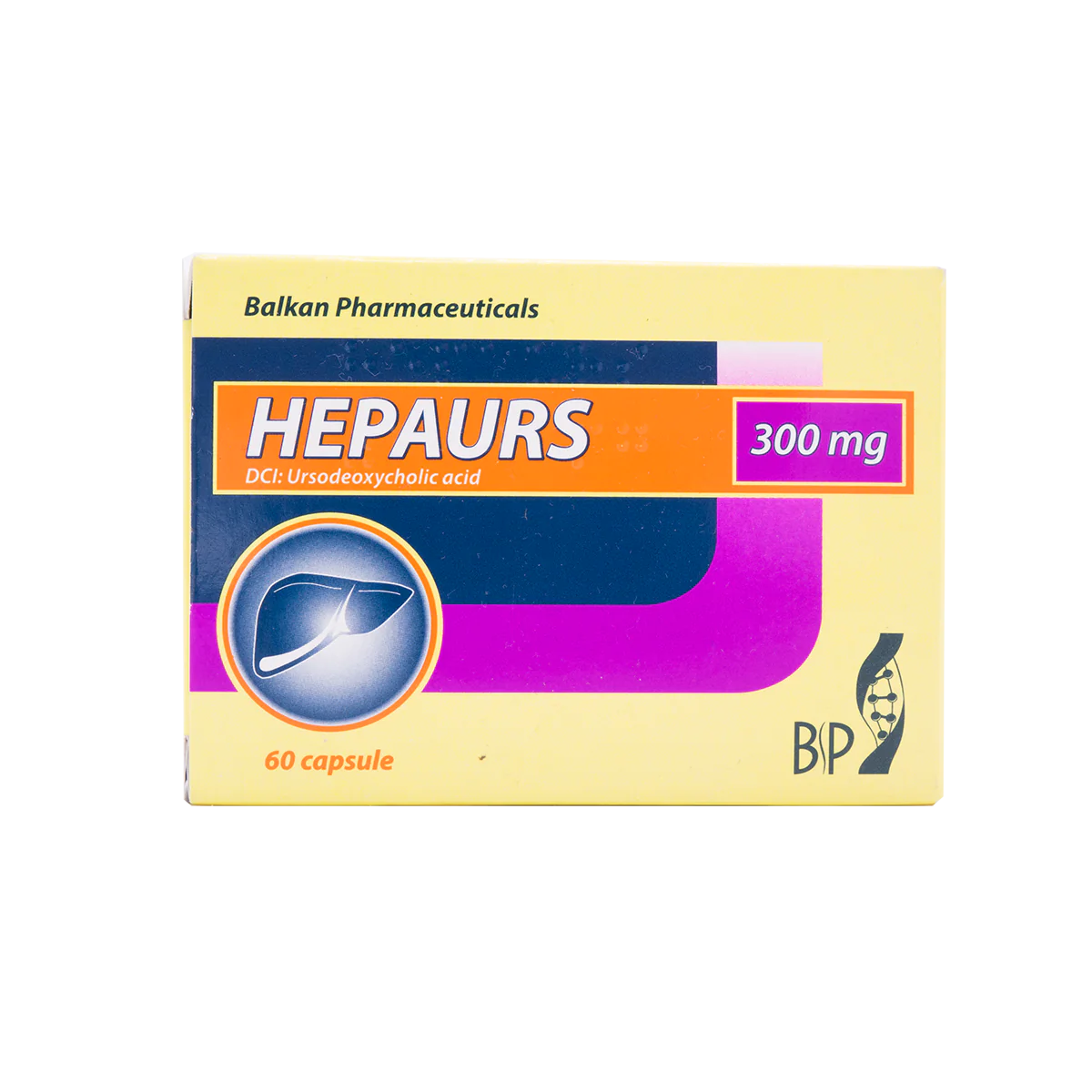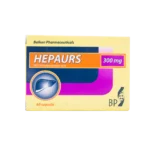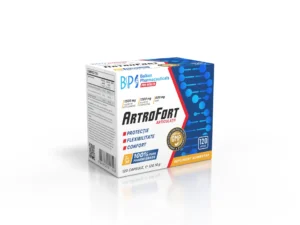BP HEPAURS
Read all of this leaflet carefully before you start taking this medicine because it contains important information for you.
– Keep this leaflet. You may need to read it again.
– If you have any further questions, ask your doctor or pharmacist.
– This medicine was prescribed only for you. You don’t have to give it to other people. It can hurt them, even if they have the same signs of illness as yours.
– If you get any side effects, talk to your doctor or pharmacist. These include any possible side effects not listed in this leaflet. See section 4.
What you find in this leaflet:
1. What Hepaurs is and what it is used for;
2. What you need to know before using Hepaurs;
3. How to use Hepaurs;
4. Possible side effects;
5. How to store Hepaurs;
6. Contents of the package and other information.
1. What Hepaurs is and what it is used for
Hepaurs contains an active substance called ursodeoxicolic acid. This is part of the class “gallbladder therapy, preparations containing bile acids”.
It is indicated in one of the following situations:
• qualitative and quantitative changes in bile function, including forms of bile secretion supersaturated with cholesterol, to prevent the formation of biliary lithiasis or to create favorable conditions for the dissolution of radiographically transparent bile calculations, with diameter below 15 mm;
• gallstones from the gallbladder and residual or recurrent calculi from the coledoc after surgery on the biliary tract; the function of the gallbladder must be intact;
• chronic hepatitis accompanied by cholestasis (particularly biliary cirrhosis).
2. What you need to know before using Hepaurs
Do not take Hepaurs:
– if you have inflammatory disease of the gallbladder,
– if you have biliary tract occlusion (cystic duct or common biliary duct),
– if you have frequent episodes of biliary colic,
– if you have calcified radiopaque calculations,
– if you have contractile dysfunction of the gallbladder,
– if you are allergic to the active substance or any of the other ingredients of this medicine (listed in section 6).
Warnings and precautions:
Before taking Hepaurs, talk to your doctor or pharmacist.
In particular, tell him if you are in one of the following situations:
– you have frequent biliary colic,
– you have changes in the activity of the pancreas or intestine, of the gall bladder;
– if you have liver cirrhosis,
– if you have diarrhea.
Your doctor will want to periodically perform some liver or radiological tests. If your doctor has warned you that you have intolerance to some carbohydrate categories, please ask your doctor before taking this medicine.
Hepaurs together with other medicines
Tell your doctor or pharmacist if you are taking, have recently taken or might take any other medicines.
In particular, tell your doctor if you are taking:
– cholestyramine,
– cholestipol,
– antacids containing aluminum hydroxide or smectite (aluminum oxide).
If, however, it is necessary to administer one such compound, it is recommended that it be administered at least 2 hours before Hepaurs.
– cyclosporine,
– ciprofloxacin,
– rosuvastatin,
– nitrendipine,
– estrogen,
– drugs for lowering cholesterol (clofibrate),
– dapson.
Pregnancy, breastfeeding and fertility
If you are pregnant or breast-feeding, think you may be pregnant, or are planning to become pregnant, consult your doctor or pharmacist for advice before taking this medicine.
Pregnancy
You should not take Hepaurs during pregnancy unless your doctor considers it absolutely necessary. Even if you are not pregnant but could become pregnant, it is advisable to talk to your doctor about contraception during treatment with Hepaurs. The use of non-hormonal or low-estrogen contraceptives is recommended. Your doctor will make sure that you are not pregnant before starting treatment with Hepaurs.
Breastfeeding
You should not take this medicine during breast-feeding. If you must take Hepaurs, breast-feeding should be discontinued.
Driving and using machines
Ursodeoxycholic acid has negligible effects or has no effect on the ability to drive or use machines.
Hepaurs contains lactose. If your doctor has warned you that you have intolerance to some carbohydrate categories, please ask your doctor before taking this medicine.
3. How to use Hepaurs
Always take this medicine exactly as your doctor or pharmacist has told you. Talk to your doctor or pharmacist if you are not sure.
Dosage
Dissolving cholesterol gallstones
The usual recommended dose is 300-600 mg per day. In order to maintain the favorable conditions for dissolving existing gallstones, treatment should last at least 4-6 months to 12 months or more, depending on the size of the calculations and the evolution under treatment.
For maintenance treatment, doses of 150 mg twice daily or 300 mg once daily are sufficient.
Biliary dyspeptic syndromes
The usual recommended dose is 300 mg daily.
Chronic liver disease with cholestasis
The usual recommended dose is up to 300 mg 2-3 times daily. The duration of treatment should be decided by the doctor depending on both the type and severity of the condition and the therapeutic response. The doses can be modified by the doctor.
If you have taken more Hepaurs than you should
The most common sign of overdose is diarrhea. If you have taken more Hepaurs than you should, contact your doctor.
If you forgot to take Hepaurs
If you forgot to take Hepaurs, take it as soon as you remember. Do not take a double dose to make up for a forgotten dose.
If you have any further questions on the use of this medicine, ask your doctor or pharmacist.
4. Possible side effects
Like all medicines, this medicine can cause side effects, although not everybody gets them. The following adverse reactions have been reported with the administration of ursodeoxicolic acid:
– diarrhea,
– pain in the upper abdomen,
– gallstones that calculate at the biliary level,
– rash circumscribed super-level with or without itching,
– red rashes,
– itching of the skin.
Reporting adverse reactions
If you experience any side effects, talk to your doctor or pharmacist. These include any possible side effects not mentioned in this leaflet. By reporting side effects, you can help provide additional information on the safety of this medicine.
5. How to store Hepaurs
Keep out of the reach and sight of children.
Keep protected from light and temperatures below 25 °C.
Do not use Hepaurs after the expiry date which is stated on the carton after “EXP”. The expiration date refers to the last day of that month.
No special storage conditions are required.
Medicines should not be disposed of via wastewater or household waste. Ask your pharmacist how to dispose of medicines you no longer need. These measures will help to protect the environment.
6. Packaging content and other information
What Hepaurs contains
Hepaurs 150 mg capsule:
– The active substance is: ursodeoxicolic acid. Each capsule contains ursodeoxycholic acid (in 100% recalcitrant anhydrous substance) 150 mg.
– The other ingredients are: lactose monohydrate, magnesium stearate.
Hepaurs 250 mg capsule:
– The active substance is: ursodeoxicolic acid. Each capsule contains ursodeoxycholic acid (in 100% recalcitrant anhydrous substance) 250 mg.
– The other ingredients are: lactose monohydrate, magnesium stearate.
Hepaurs 300 mg capsule:
– The active substance is: ursodeoxicolic acid. Each capsule contains ursodeoxycholic acid (in 100% recalcitrant anhydrous substance) 300 mg.
– The other ingredients are: lactose monohydrate, magnesium stearate.
What Hepaurs looks like and contents of the pack
Hepaurs 150 mg
Cylindrical shaped capsules, with hemispherical ends, with smooth and opaque surface, capsule number 1.
The body – white and the cover blue-light, the body – white and the cover – white, the body – blue and the cover – blue-light.
Capsule content:
White or almost white powder, practically odorless. Box with 6 transparent PVC / Al blisters each containing 10 capsules.
Hepaurs 250 mg
Cylindrical shaped capsules, with hemispherical ends, with smooth and opaque surface, capsule number 1.
The body – white and the cover blue-light, the body – white and the cover – white, the body – blue and the cover – blue-light.
Capsule content:
White or almost white powder, practically odorless. Box with 6 transparent PVC / Al blisters each containing 10 capsules.
Hepaurs 300 mg
Cylindrical shaped capsules, with hemispherical ends, with smooth and opaque surface, capsule number 0.
The body – white and the cover blue-light, the body – white and the cover – white, the body – blue and the cover – blue-light.
Capsule content:
White or almost white powder, practically odorless. Box with 6 transparent PVC / Al blisters each containing 10 capsules. DG Winstrol 10









Reviews
There are no reviews yet.